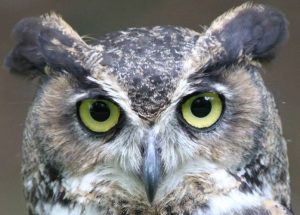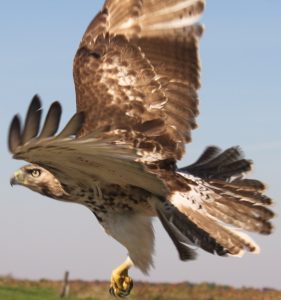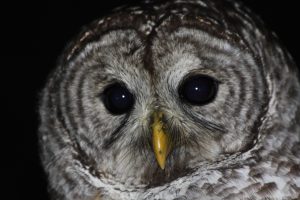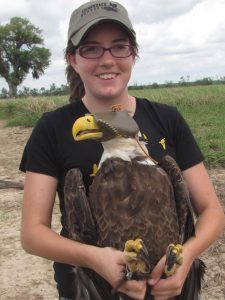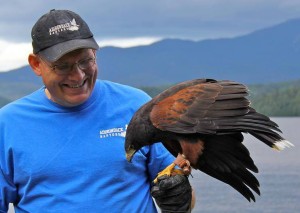Banding together for raptor research: P-R writer learns from nature expert
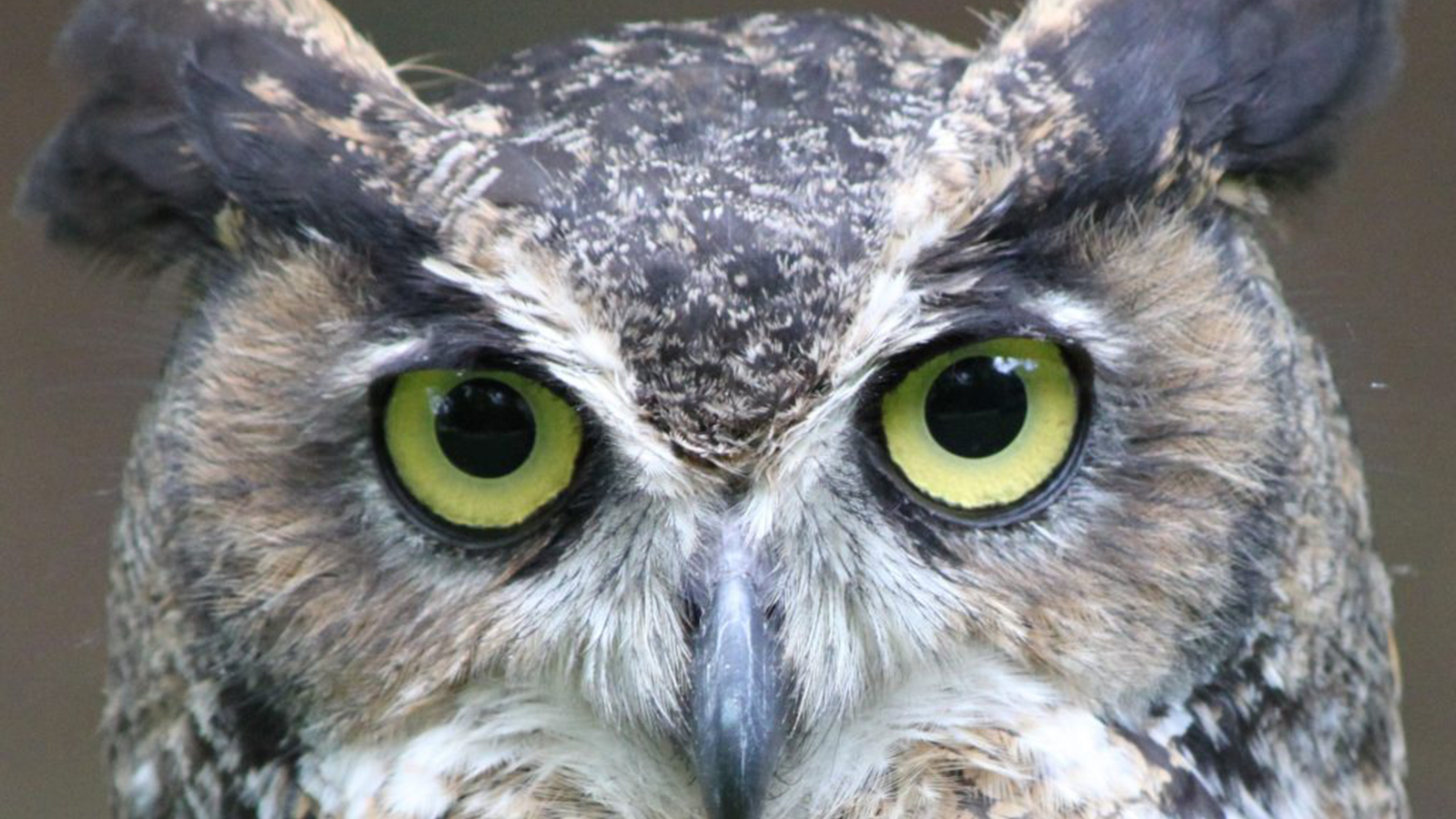
By Chris Fasolino Press-Republican | Posted: Sunday, November 2, 2014 12:00 am
I had just finished supper when a man walked into the room with a great horned owl on his shoulders.The setting was the balcony of a Lake Placid Restaurant. The owl was Scooter. The man was Mark Manske of Adirondack Raptors. Manske and Scooter were there for a bird-of-prey show. Surprised and happy to have stumbled upon the event — or to have the event stumble upon me — I went outside to watch. Along with Scooter, Manske was accompanied by Frieda, the Harris hawk; Tessie, the barn owl; and Pippin, the kestrel. The birds were fascinating and beautiful, and eager guests such as myself got to participate.
Manske placed a heavy, leather glove on one of my hands and allowed me to hold Tessie, and then Pippin, who were secured on lead lines. I enjoyed running my fingers through Tessie’s soft feathers. Since owls hunt by stealth, Manske explained, their feathers are very soft, which makes their flight very quiet. When I held Pippin, he quickly decided to land on my head (I was wearing an Irish cap at the time, and I have concluded that kestrels love Donegal tweed).
It was a delightful evening, and it inspired me to call Manske to see if I could join him on an adventure in the field. One of the options described on his website, adirondackraptors.org, is to participate in banding birds. Intrigued, I arranged to meet him at his home in Dickinson Center to help band red-tailed hawks.
A NATURALIST’S METHODS
It was a cool, autumn day, and I drove to Manske’s home under a grey, cloudy sky traversed by migrating geese.
At one point, there was a large “V” right above me, and I had the curious sensation that the geese and I were headed in the same direction; however, they soon veered away. No doubt their final destination was someplace a bit warmer than Dickinson Center. Soon thereafter, I passed an Amish buggy, and the driver returned my wave with stately courtesy.
I arrived at Manske’s home and met his dogs: Daila, a chocolate lab, and Buddy, a springer spaniel/Brittany spaniel mix. Manske told me about Daila back when we met in Lake Placid, relating tales of her unlikely but affectionate friendship with Pippin the kestrel. Soon, Manske and I were on the road in his truck, in search of red-tailed hawks. Having banded some 9,000 birds, of many species, in his lifetime, Manske can speak from experience about the purpose and the methods of banding. “The reason we band birds is because our world is changing,” he said. With human activity affecting the environment in many different ways, and with fears that a major extinction period may be imminent, Manske believes it is important to have data about wildlife populations.
BAL CHATRIS
At night, Manske bands saw-whet owls, capturing the creatures using mist-nets. The nets are so-called because they are extremely fine. Manske uses a recording of the saw-whet owl’s call to draw the creatures, which are gregarious in nature, toward the nets. Then, he can collect data about their size and health, band them, and release them. So far this year, Manske has banded some 50 saw-whet owls.
A very different method is required for red-tailed hawks. A special kind of catch-and-release trap called a bal chatris is used. It is a wire cage with knots of fishing line all around the outside. Bait is placed within the cage, and when the hawk tries to seize the bait, its talons become caught in the loops of fishing line. The trap is heavy enough to prevent the hawk from flying away, but light enough so that it will not injure itself as it tries. In effect, the trap anchors the hawk to the ground, allowing Manske to catch and examine it, band it, and then release it.
Manske explained that the design of the bal chatris is centuries old and dates back to Arabian lands, where the traps were made of reeds and camel hair, and the captured birds of prey were used for falconry.
When we spotted a red-tailed hawk, Manske would set out the trap and then drive to a spot nearby where we could wait and watch. Manske always stays within sight of a bal chatris trap, so that he can pick up the hawk right away; thus, the animal does not remain vulnerable. In fact, much of his time working banding red-tailed hawks actually consists of watching and waiting.
Manske compares the experience to fishing.
“He’s starting to look in the right direction,” Manske said of the hawk we were watching. “They crane their necks, and they start shifting. He definitely sees it at this point. He’s doing everything picture-perfect; this is what they do when they’re getting ready to go.” But this hawk never went. His attention seemed to wander. “He was locked in, but now he’s looking around, looking for other options.” If it was an older bird, Manske noted, it may have seen a trap before. “They are wily.”
‘EAGLE PADDLE’
After retrieving the trap, we continued on, crossing the Raquette River near the point where it enters the St. Lawrence. Manske recalled an eagle rescue he had carried out in the vicinity two years ago. A wounded bald eagle had been spotted; it turned out that the bird’s wing was broken. Manske did not know how the eagle was injured, but he was determined to rescue it. As he was trying to do so, however, the bird entered the river and started swimming. “They can eagle paddle,” Manske said wryly. “We had to dive in the water to catch it.” The bird was rescued and transported to Adirondack Wildlife Refuge Rehabilitation Center in Wilmington.
We drove under the Eisenhower Locks and proceeded to an area of rolling countryside covered with thick underbrush and dotted with trees. The spot is bordered by the St. Lawrence River on two sides, and by shipping locks on another. Since many birds follow the river, and since the habitat is favorable, Manske has identified this as a rich area for birds of prey, and plans to set up a banding station here next year.
Sure enough, we spotted a Cooper’s hawk. However, it flew away before Manske could set out the trap. Had he been able to trap the Cooper’s hawk, Manske would have used a cheek swab to take a DNA sample in addition to the other information that he collects. One of his former students, now a Ph.D. candidate, is analyzing the DNA of certain types of birds of prey. Manske works with students from Paul Smith’s and other area colleges who are interested in studying wildlife. He recalls joking with students at times by telling them that he has a “tingly feeling” indicating that birds of prey are nearby; soon thereafter, the birds would actually be spotted.
“I had them hooked,” Manske said of the students, with a wry laugh. In fact, his “tingly feeling” was simply the result of knowledge and experience about the kind of environments raptors prefer, along with a habit of keen observation. I suggested that it was a bit like Sherlock Holmes’ deductive reasoning; it would seem amazing to someone else, but to him — “It’s elementary,” said Manske, finishing the thought with a laugh.
BANDING A RED-TAILED HAWK
We saw several red-tailed hawks that morning, along with the Cooper’s hawk and a northern harrier. Manske said that people who ride with him on these expeditions often say, “I’m out here all the time and I never see that many birds.” To which Manske responds: “It’s probably because you never looked for them.” Eventually, a red-tailed hawk responded to the trap. As we watched, it flew overhead and then swooped down on the bal chatris. As we got out of the vehicle and approached, I could see that the trap did indeed act like an anchor, preventing the hawk from flying away.
Manske retrieved the hawk and, drawing on years of training and experience, carried it in his arms in such a way that neither the animal nor he himself would be injured. He carried it to the back of his truck where he could take measurements and band the creature. And then, to my amazement, he showed me how to hold the hawk.
Manske placed a towel over the hawk’s head, which served to calm the animal; and he showed me how to hold the bottom of its legs, above the feet, so that it would not attack us. He instructed me to hold tightly. Looking at the long, sharp talons, I followed his instructions very, very carefully.
At the same time, I gazed in wonder and admiration at the beautiful bird that was now in my arms. The towel slipped down slightly, and I could see the hawk’s wide, bright yellow eyes. This was a young red-tailed hawk, though fully grown; the eyes darken with age, Manske said. I admired the beauty of its plumage, white and brown and russet. I looked at the straight tail feathers and could imagine how the tail acted like a rudder, playing its role in changes of direction during flight. “I’ve never had a red-tailed hawk on my lap before,” I said in amazement at the experience. “Not many people have,” said Manske.
He placed the numbered band above the hawk’s right foot. Then, he measured the tail feathers and the wing cord — the distance between the bird’s “wrist” and its wingtip — and he weighed the creature on a portable scale. He also checked it for parasites — it was clean. He felt its keel — a ridge of bone — to estimate how well the bird had been feeding. A protruding keel would indicate lean times. Happily, this bird was quite well-fed. Using a scale of 1 to 6, with 1 indicating near starvation and 6 being the other extreme, our hawk was a healthy 5. Then, it was time to release the animal. Manske lifted the hawk up into the air, and it took off, flying to a tree in a nearby field.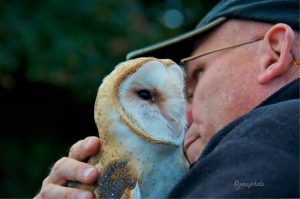
The data had been carefully recorded in Manske’s notebook. From there, it would become part of a scientific database, accessible to environmental researchers and natural historians. Meanwhile, the hawk would continue its life in the wild. Now, the red-tailed hawk perched in the tree, looking out over the autumn fields. Hopefully, there are many flights ahead of it.


